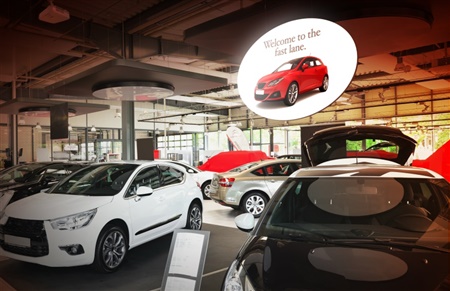SSZTA21 July 2017 DLP470NE , DLP480RE , DLP650NE , DLP660TE , DLPA100 , DLPA1000 , DLPC4422
Digital signage is changing the way consumers receive information. Companies are actively looking for new techniques to engage and attract people to their products and services. However, many businesses and consumers think digital signage is limited to flat-panel displays. Flat-panel displays do have several limitations – particularly size and space constraints. They are physically large, heavy, flat and ultimately limited to a rectangular design, making it difficult to find new ways to differentiate. Figure 1 shows an example of how a relatively small projection unit can enable large free-form displays at an exhibition or show floor. Incorporating projection technology is the next step for digital signage to increase the effectiveness of signage solutions and provide a more engaging viewing experience.
 Figure 1 Free-form Image Projection
Figure 1 Free-form Image ProjectionProjection Technology in Digital Signage
Digital signage uses a display to show some form of content with the goal of communicating with an end user, whether that is a member of the public or an employee. Currently, digital signage provides the ability to display real-time data such as product and price updates to drive more relevant information to people faster.
Projection technology stands to open new avenues for digital signage to reach even more people by providing the capability to display practically anywhere, with extremely large image sizes while being integrated directly into a setting or product environment. Projection, with the aid of image processing, can map images onto a variety of geometric surfaces, blend multiple images together to create displays covering entire buildings, and conduct image tracking to show a static image on a moving object. Figure 2 illustrates how in a retail atmosphere, projection based displays can be used to show product information instantaneously and dynamically appear when someone picks up a product. These incredible features make projection the obvious next step in the evolution of digital signage.
 Figure 2 Projection Displays in Retail Signage
Figure 2 Projection Displays in Retail SignageDLP® Technology Brings Unique Advantages to Digital Signage
DLP technology has a wide variety of display chips, also known as digital micromirror devices (DMDs), to meet multiple system requirements and applications. Different DMD chips fit different form factors and specifications. The DLP660TE DMD and DLPC4422 high-speed controller enable swift refresh rates with low latency at 4K ultra-high-definition (UHD) resolution for fast-paced video and stunning still images.
DLP technology provides customers with bright, high-resolution solutions that are capable of working with virtually any light source; including LED’s and lasers for laser projection. With an extensive ecosystem of optical module manufacturers and design houses, you can quickly evaluate the technology and accelerate the design process.
Digital Signage Solutions Currently Using Projection
Projection technology is already making an impact in digital signage as it becomes more commercially available as a solution. Companies like Projection Artworks and Glass-Media are leading the way with incredible, captivating digital signage solutions. The Projection Artworks DisplayMapper transforms any DLP projector into an interactive video-mapping powerhouse with its easy-to-use functions for projection mapping, projector stacking and edge-blending capabilities. Glass-Media, Inc. specializes in projection-based, end-to-end, digital point-of-presence solutions for brands with physical footprints. Through the company's proprietary display substrates and analytically infused Internet of Things (IoT) platform, Glass-Media uniquely empowers brick-and-mortar brands to achieve more with DLP projection. Many more companies are expected to follow as projection becomes more main-stream within the digital signage industry.
Join the revolution and create a new generation of digital signage projection displays with DLP technology. To learn more about DLP technology for digital signage, read the white paper, “Using TI DLP technology to make digital signage more effective.”
Additional Resources
- Download the application report, “Getting Started with DLP Display Technology.”
- Check out the 4K UHD High Brightness Display Reference Design Using TI DLP Technology.